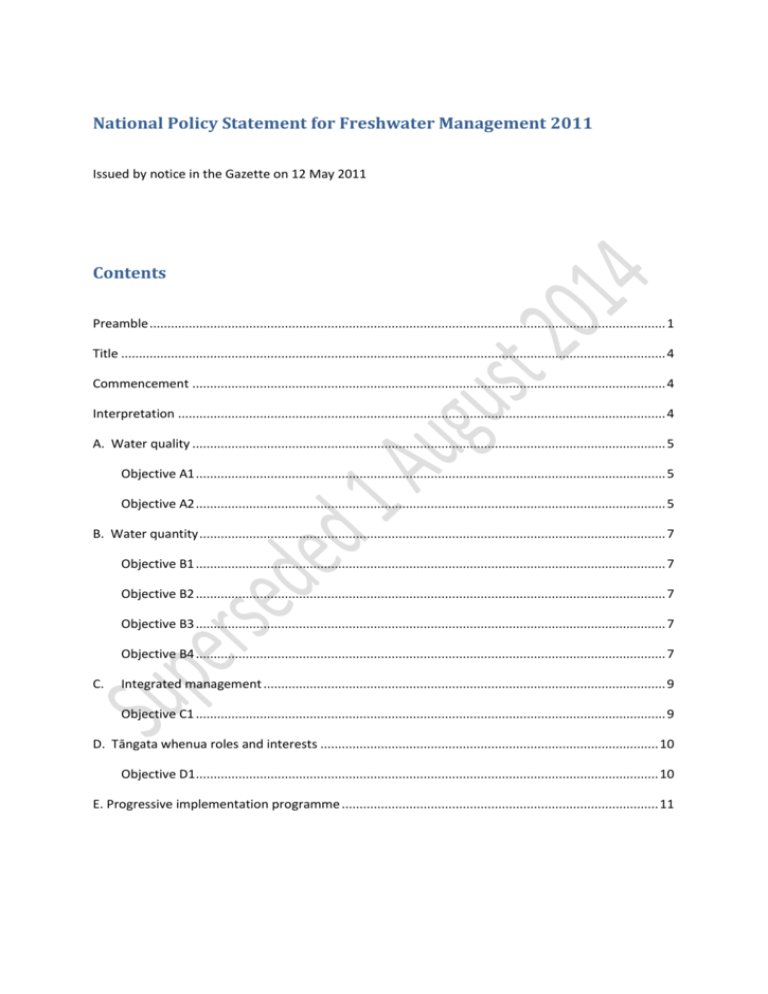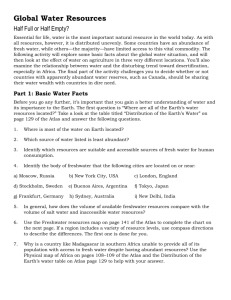NPS-freshwater-management
advertisement

National Policy Statement for Freshwater Management 2011 Issued by notice in the Gazette on 12 May 2011 Contents Preamble ................................................................................................................................................. 1 Title ......................................................................................................................................................... 4 Commencement ..................................................................................................................................... 4 Interpretation ......................................................................................................................................... 4 A. Water quality ..................................................................................................................................... 5 Objective A1 .................................................................................................................................... 5 Objective A2 .................................................................................................................................... 5 B. Water quantity ................................................................................................................................... 7 Objective B1 .................................................................................................................................... 7 Objective B2 .................................................................................................................................... 7 Objective B3 .................................................................................................................................... 7 Objective B4 .................................................................................................................................... 7 C. Integrated management ................................................................................................................. 9 Objective C1 .................................................................................................................................... 9 D. Tāngata whenua roles and interests ............................................................................................... 10 Objective D1 .................................................................................................................................. 10 E. Progressive implementation programme ......................................................................................... 11 Preamble Fresh water is essential to New Zealand’s economic, environmental, cultural and social wellbeing. Fresh water gives our primary production, tourism, and energy generation sectors their competitive advantage in the global economy. Fresh water is highly valued for its recreational aspects and it underpins important parts of New Zealand’s biodiversity and natural heritage. Fresh water has deep cultural meaning to all New Zealanders. Many of New Zealand’s lakes, rivers and wetlands are iconic and well known globally for their natural beauty and intrinsic values. The Treaty of Waitangi (Te Tiriti o Waitangi) is the underlying foundation of the Crown– iwi/hapū relationship with regard to freshwater resources. Addressing tāngata whenua values and interests across all of the well-beings, and including the involvement of iwi and hapū in the overall management of fresh water, are key to meeting obligations under the Treaty of Waitangi. All New Zealanders have a common interest in ensuring the country’s freshwater lakes, rivers, aquifers and wetlands are managed wisely. New Zealand faces challenges in managing our fresh water to provide for all of the values that are important to New Zealanders. The quality, health, availability and economic value of our fresh waters are under threat. These challenges are likely to increase over time due to the impacts of climate change. To respond effectively to these challenges and issues we need to have a good understanding of our freshwater resources, the threats to them and provide a management framework that enables water to contribute both to New Zealand’s economic growth and environmental integrity and provides for the values that are important to New Zealanders. This national policy statement sets out objectives and policies that direct local government to manage water in an integrated and sustainable way, while providing for economic growth within set water quantity and quality limits. The national policy statement is a first step to improve freshwater management at a national level. Setting enforceable quality and quantity limits is a key purpose of this national policy statement. This is a fundamental step to achieving environmental outcomes and creating the necessary incentives to use fresh water efficiently, while providing certainty for investment. Water quality and quantity limits must reflect local and national values. The process for setting limits should be informed by the best available information and scientific and socioeconomic knowledge. Once limits are set, freshwater resources need to be allocated to users, while providing the ability to transfer entitlements between users so that we maximise the value we get from water. Where water resources are over-allocated (in terms of quality and quantity) to the point that national and local values are not met, we also need to ensure that over-allocation is reduced over agreed timeframes. 1 Given the vital importance of freshwater resources to New Zealand and New Zealanders, and in order to achieve the purpose of the Resource Management Act 1991 (the Act), the Crown recognises there is a particular need for clear central government policy to set a national direction, though the management of the resource needs to reflect the catchment-level variation between water bodies and different demands on the resource across regions. This includes managing land use and development activities that affect water so that growth is achieved with a lower environmental footprint. The New Zealand Coastal Policy Statement 2010 addresses issues with water quality in the coastal environment. The management of coastal water and fresh water requires an integrated and consistent approach. National values of fresh water Water is valued for the following uses: domestic drinking and washing water animal drinking water community water supply fire fighting electricity generation commercial and industrial processes irrigation recreational activities (including waka ama) food production and harvesting eg, fish farms and mahinga kai transport and access (including tauranga waka) cleaning, dilution and disposal of waste. There are also values that relate to recognising and respecting fresh water’s intrinsic values for: safeguarding the life-supporting capacity of water and associated ecosystems; and sustaining its potential to meet the reasonably foreseeable needs of future generations. Examples of these values include: the interdependency of the elements of the freshwater cycle the natural form, character, functioning and natural processes of water bodies and margins, including natural flows, velocities, levels, variability and connections the natural conditions of fresh water, free from biological or chemical alterations resulting from human activity, so that it is fit for all aspects of its intrinsic values healthy ecosystem processes functioning naturally healthy ecosystems supporting the diversity of indigenous species in sustainable populations cultural and traditional relationships of Māori with fresh water historic heritage associations with fresh water providing a sense of place for people and communities. All the values in both lists are important national values of fresh water. 2 Review The Minister for the Environment intends to seek an independent review of the implementation and effectiveness of this national policy statement in achieving all its objectives and policies and in achieving the purpose of the Act, no later than five years after it comes into force. The Minister shall then consider the need to review, change or revoke this national policy statement. Collection of monitoring data to inform this review will begin at least two years prior to the review. This preamble may assist the interpretation of the national policy statement. 3 Title This national policy statement is the National Policy Statement for Freshwater Management 2011. Commencement This national policy statement will take effect on 1 July 2011. Interpretation In this national policy statement: “Efficient allocation” includes economic, technical and dynamic efficiency. “Environmental flows and/or levels” are a type of limit which describes the amount of water in a body of fresh water (except ponds and naturally ephemeral water bodies) which is required to meet freshwater objectives. Environmental flows for rivers and streams must include an allocation limit and a minimum flow (or other flow/s). Environmental levels for other bodies of fresh water must include an allocation limit and a minimum water level (or other level/s). “Freshwater objective” describes the intended environmental outcome(s). “Limit” is the maximum amount of resource use available, which allows a freshwater objective to be met. “Over-allocation” is the situation where the resource: a) has been allocated to users beyond a limit or b) is being used to a point where a freshwater objective is no longer being met. This applies to both water quantity and quality. “Outstanding freshwater bodies” are those water bodies with outstanding values, including ecological, landscape, recreational and spiritual values. “Target” is a limit which must be met at a defined time in the future. This meaning only applies in the context of over-allocation. Terms given meaning in the Act have the meanings so given. 4 A. Water quality Objective A1 To safeguard the life-supporting capacity, ecosystem processes and indigenous species including their associated ecosystems of fresh water, in sustainably managing the use and development of land, and of discharges of contaminants. Objective A2 The overall quality of fresh water within a region is maintained or improved while: a. protecting the quality of outstanding freshwater bodies b. protecting the significant values of wetlands and c. improving the quality of fresh water in water bodies that have been degraded by human activities to the point of being over-allocated. Policy A1 By every regional council making or changing regional plans to the extent needed to ensure the plans: a. establish freshwater objectives and set freshwater quality limits for all bodies of fresh water in their regions to give effect to the objectives in this national policy statement, having regard to at least the following: i. the reasonably foreseeable impacts of climate change ii. the connection between water bodies b. establish methods (including rules) to avoid over-allocation. Policy A2 Where water bodies do not meet the freshwater objectives made pursuant to Policy A1, every regional council is to specify targets and implement methods (either or both regulatory and non-regulatory) to assist the improvement of water quality in the water bodies, to meet those targets, and within a defined timeframe. Policy A3 By regional councils: a. imposing conditions on discharge permits to ensure the limits and targets specified pursuant to Policy A1 and Policy A2 can be met and b. where permissible, making rules requiring the adoption of the best practicable option to prevent or minimise any actual or likely adverse effect on the environment of any discharge of a contaminant into fresh water, or onto or into land in circumstances that may result in that contaminant (or, as a result of any natural process from the discharge of that contaminant, any other contaminant) entering fresh water. 5 Policy A4 and direction (under section 55) to regional councils By every regional council amending regional plans (without using the process in Schedule 1) to the extent needed to ensure the plans include the following policy to apply until any changes under Schedule 1 to give effect to Policy A1 and Policy A2 (freshwater quality limits and targets) have become operative: “1. When considering any application for a discharge the consent authority must have regard to the following matters: a. the extent to which the discharge would avoid contamination that will have an adverse effect on the life-supporting capacity of fresh water including on any ecosystem associated with fresh water and b. the extent to which it is feasible and dependable that any more than minor adverse effect on fresh water, and on any ecosystem associated with fresh water, resulting from the discharge would be avoided. 2. This policy applies to the following discharges (including a diffuse discharge by any person or animal): a. a new discharge or b. a change or increase in any discharge – of any contaminant into fresh water, or onto or into land in circumstances that may result in that contaminant (or, as a result of any natural process from the discharge of that contaminant, any other contaminant) entering fresh water. 3. This policy does not apply to any application for consent first lodged before the National Policy Statement for Freshwater Management takes effect on 1 July 2011.” 6 B. Water quantity Objective B1 To safeguard the life-supporting capacity, ecosystem processes and indigenous species including their associated ecosystems of fresh water, in sustainably managing the taking, using, damming, or diverting of fresh water. Objective B2 To avoid any further over-allocation of fresh water and phase out existing over-allocation. Objective B3 To improve and maximise the efficient allocation and efficient use of water. Objective B4 To protect significant values of wetlands. Policy B1 By every regional council making or changing regional plans to the extent needed to ensure the plans establish freshwater objectives and set environmental flows and/or levels for all bodies of fresh water in its region (except ponds and naturally ephemeral water bodies) to give effect to the objectives in this national policy statement, having regard to at least the following: a. the reasonably foreseeable impacts of climate change b. the connection between water bodies. Policy B2 By every regional council making or changing regional plans to the extent needed to provide for the efficient allocation of fresh water to activities, within the limits set to give effect to Policy B1. Policy B3 By every regional council making or changing regional plans to the extent needed to ensure the plans state criteria by which applications for approval of transfers of water take permits are to be decided, including to improve and maximise the efficient allocation of water. Policy B4 By every regional council identifying methods in regional plans to encourage the efficient use of water. 7 Policy B5 By every regional council ensuring that no decision will likely result in future over-allocation – including managing fresh water so that the aggregate of all amounts of fresh water in a water body that are authorised to be taken, used, dammed or diverted – does not over-allocate the water in the water body. Policy B6 By every regional council setting a defined timeframe and methods in regional plans by which over-allocation must be phased out, including by reviewing water permits and consents to help ensure the total amount of water allocated in the water body is reduced to the level set to give effect to Policy B1. Policy B7 and direction (under section 55) to regional councils By every regional council amending regional plans (without using the process in Schedule 1) to the extent needed to ensure the plans include the following policy to apply until any changes under Schedule 1 to give effect to Policy B1 (allocation limits), Policy B2 (allocation), and Policy B6 (over-allocation) have become operative: “1. When considering any application the consent authority must have regard to the following matters: a. the extent to which the change would adversely affect safeguarding the lifesupporting capacity of fresh water and of any associated ecosystem and b. the extent to which it is feasible and dependable that any adverse effect on the life-supporting capacity of fresh water and of any associated ecosystem resulting from the change would be avoided. 2. This policy applies to: a. any new activity and b. any change in the character, intensity or scale of any established activity – that involves any taking, using, damming or diverting of fresh water or draining of any wetland which is likely to result in any more than minor adverse change in the natural variability of flows or level of any fresh water, compared to that which immediately preceded the commencement of the new activity or the change in the established activity (or in the case of a change in an intermittent or seasonal activity, compared to that on the last occasion on which the activity was carried out). 3. This policy does not apply to any application for consent first lodged before the National Policy Statement for Freshwater Management takes effect on 1 July 2011.” 8 C. Integrated management Objective C1 To improve integrated management of fresh water and the use and development of land in whole catchments, including the interactions between fresh water, land, associated ecosystems and the coastal environment. Policy C1 By every regional council managing fresh water and land use and development in catchments in an integrated and sustainable way, so as to avoid, remedy or mitigate adverse effects, including cumulative effects. Policy C2 By every regional council making or changing regional policy statements to the extent needed to provide for the integrated management of the effects of the use and development of land on fresh water, including encouraging the co-ordination and sequencing of regional and/or urban growth, land use and development and the provision of infrastructure. 9 D. Tāngata whenua roles and interests Objective D1 To provide for the involvement of iwi and hapū, and to ensure that tāngata whenua values and interests are identified and reflected in the management of fresh water including associated ecosystems, and decision-making regarding freshwater planning, including on how all other objectives of this national policy statement are given effect to. Policy D1 Local authorities shall take reasonable steps to: a. involve iwi and hapū in the management of fresh water and freshwater ecosystems in the region b. work with iwi and hapū to identify tāngata whenua values and interests in fresh water and freshwater ecosystems in the region and c. reflect tāngata whenua values and interests in the management of, and decisionmaking regarding, fresh water and freshwater ecosystems in the region. 10 E. Progressive implementation programme Policy E1 a. This policy applies to the implementation by a regional council of a policy of this national policy statement. b. Every regional council is to implement the policy as promptly as is reasonable in the circumstances, and so it is fully completed by no later than 31 December 2030. c. Where a regional council is satisfied that it is impracticable for it to complete implementation of a policy fully by 31 December 2014, the council may implement it by a programme of defined time-limited stages by which it is to be fully implemented by 31 December 2030. d. Any programme of time-limited stages is to be formally adopted by the council within 18 months of the date of gazetting of this national policy statement, and publicly notified. e. Where a regional council has adopted a programme of staged implementation, it is to publicly report, in every year, on the extent to which the programme has been implemented. 11








